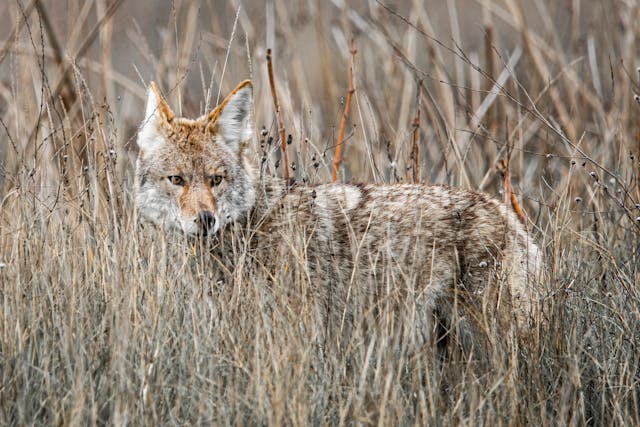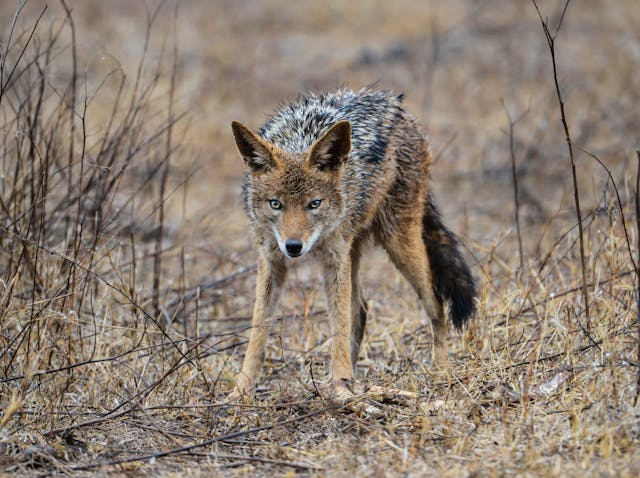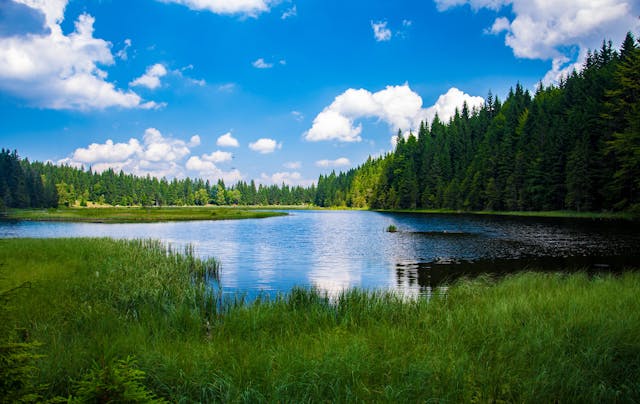The shroud of nightfall incites a remarkable metamorphosis in the behavioral patterns of coyotes, rendering them increasingly elusive and vigilant. The twilight hours bestow upon these beasts an opportunist’s guise, compelling them to seize any chance that presents itself for hunting and feeding. This adaptability morphs nocturnal coyote hunting in Tennessee into a demanding yet fulfilling quest, equally tantalizing for both veteran and fledgling hunters.
Night’s veil imparts audacity onto these creatures, stirring up a heightened level of activity and boldness than what is displayed under the scrutiny of daylight. Their acute auditory perception coupled with their refined olfactory senses lend them an edge amidst the obscurity brought forth by nightfall. Consequently, coyotes evolve into the epitome of predators ideally equipped for nighttime escapades.
Thus comprehending this innate shift in coyote behavior after sundown becomes a cornerstone strategy in ensuring triumphant hunts during Tennessee’s nocturnal coyote excursions.
To fully grasp the essence of coyote behavior in darkness, one must take into account several key factors:
- Coyotes are inherently nocturnal creatures: Their biological clock is naturally tuned to be most active during twilight and nighttime hours. This trait is significantly amplified when they are in hunting mode.
- Enhanced sensory perception: The auditory and olfactory senses of coyotes become remarkably heightened under the cover of darkness. They rely heavily on these enhanced abilities to detect potential prey, making them formidable predators even amidst the obscurity brought forth by nightfall.
- Increased boldness and activity levels: Nighttime seems to embolden these creatures, prompting a surge in their level of activity. This audacity combined with their acute predatory instincts makes them particularly elusive targets for hunters.
To ensure successful hunts during Tennessee’s nocturnal coyote excursions, it becomes essential for hunters to comprehend and adapt accordingly:
- Understanding predator-prey dynamics: Recognizing how coyotes hunt can provide valuable insights into predicting their movements and strategizing effectively.
- Utilizing appropriate equipment: Given that visibility is considerably reduced at night, using specialized hunting gear such as thermal scopes or night vision goggles can offer a significant advantage.
- Emphasizing stealth tactics: As coyotes become more alert at night, maintaining silence and minimizing movement becomes crucial in avoiding detection.
In conclusion, understanding the behavioral shift exhibited by coyotes after sundown provides invaluable knowledge for those seeking success in nocturnal hunting pursuits. By combining this comprehension with effective strategies tailored specifically for nighttime conditions, both veteran and fledgling hunters can look forward to rewarding experiences on Tennessee’s darkened plains.
The Necessary Gear for Nocturnal Predator Pursuits
The efficacy of your after-dark endeavours hinges critically on dependable equipment. It may well be the determinant between a triumphant Tennessee coyote track and an unsatisfying venture into nocturnal blackness. As such, your selected gear ought to offer ample support for your night-time pursuits, guaranteeing success in your endeavors. This encompasses all essentials ranging from suitable attire and accurate hunting tools to top-tier night vision scopes alongside trail cameras.
Speaking of potential targets’ proportions, Tennessee coyotes typically tip the scales at 20 to 50 pounds; thus implying that high-caliber rifles might not be obligatory for these hunts. Your firearm preference largely rests upon the gap separating you from the coyote. Other indispensable articles within your after-dark arsenal include efficient flashlights or headlamps along with night vision apparatuses. These ensure competent navigation during twilight hours, precise sighting and discernment among various animals thereby mitigating unwanted mishaps.
Legal Considerations for After-Dark Hunts in the Volunteer State

Within the grand and gallant Volunteer State of Tennessee, it becomes a necessity to have an acute understanding of the rules accompanying nocturnal coyote hunts. It’s worth noting that these laws are chiefly constructed for the protection of both hunters and nature alike. One query often bouncing around in the minds of those intrigued by this pursuit is “Does one require a license to hunt coyote in Tennessee?” This question finds itself echoing within circles of novice and seasoned hunters equally, therefore demanding a thorough answer to dismiss any potential confusion.
The Tennessee Wildlife Resources Agency puts forth quite unequivocally that every hunter, be they native or non-resident, hoping to track down coyotes must indeed hold an authentic hunting license. The acquisition process should take place significantly ahead of the planned hunting trip; authorities placing emphasis on grasping all safety regulations associated with it. Furthermore, it’s vital not to overlook that certain state lands prohibit coyote hunting altogether and nighttime hunting legislation can fluctuate across different areas within Tennessee. As such, ensuring adherence to these regulations falls squarely upon the shoulders of each prospective hunter.
Safety Precautions for Pursuing Predators After Sunset
Plunging into the nocturnal realm of hunting, particularly in pursuit of predators, demands an elevated consciousness towards safety measures. It is paramount to have proficiency in handling your hunting gear under the shroud of nightfall. Ponder for instance a question frequently voiced by Tennessee hunters – ‘Is there permission to hunt coyotes using buckshot?’ Affirmative is the response, yet it calls for superior precision when deploying buckshot. This aspect holds high importance as midnight hunting can be typified by erratic elements and the efficacy of your gear could tip scales between triumphant hunts or potential perils.
Moreover, maintaining a diligent watch on existing and imminent weather conditions becomes vital as visibility might undergo severe alterations thereby impacting both safety and overall hunting experience. Tools providing adequate illumination are hence indispensable for spotting hazards which may otherwise remain veiled in darkness. Apparatus like night vision optics can markedly augment visibility allowing hunters to trail and successfully hunt down coyotes. Whilst Tennessee permits hunting coyotes with buckshot, precision paired with due emphasis on safety should always take precedence ensuring fruitful encounters devoid any risks during such nocturnal adventures.
Methods for Attracting Coyotes in Darkness
In the ever-shifting chessboard of nighttime predator pursuits, commonly practiced in a myriad of locales including Tennessee, professional hunters are astutely harnessing the fruits of technological progression. A prime specimen of such avant-garde tools being harnessed extensively is electronic calls. These machines have demonstrated an undeniable potency in coaxing coyotes from their sanctuaries, even under the cloak of the darkest nightfall.
The sonic spectrum these electronic alarums can produce – fluctuating between anguished rabbit shrieks to faultlessly replicated coyote ululations – serve as potent siren songs too tantalizing for even these wily predators to brush aside.
Furthermore, posed questions like “Is it lawful to employ electronic calls when hunting coyotes in Tennessee?” provoke deliberations on legal parameters given that wildlife stipulations differ widely across territories. Confirmatively though, the legislative framework within Tennessee does greenlight this practice. Intriguingly enough, skilled operators possess the ability to modulate call intensities at will – thereby evaluating and adapting to lured coyote behavior patterns and significantly reducing inherent risk factors.
This tactical deployment of electronic calls thus catapults nocturnal coyote hunting phenomenally higher into a realm where technology meets tradition.
How to Recognize and Track Coyote Signs at Night
The veil of night may shroud the landscape in a mystifying obscurity, presenting an intimidating challenge to hunters unfamiliar with tracking elusive coyote signs. Yet, it is this very enigma that forms the bedrock of nocturnal predatory pursuit. Kentucky’s seasoned hunters, who are permitted to engage in after-dark hunting escapades of these creatures, possess intimate knowledge of the unique traits exhibited by these nocturnal marauders. These indications could encompass identifiable tracks or droppings and even evidence of feeding activity—all accentuated beneath the soft glow emitted from moon and stars. Fathoming such signs escalates your chances for a bountiful hunt while offering priceless glimpses into coyote conduct—thereby enhancing your overall expedition experience.
“Is it permissible to stalk coyotes under cover of darkness in Kentucky?” This query frequently echoes amongst greenhorn hunters—the response being an unequivocal affirmation! However, mastering this art requires more than mere sharp eyesight—it demands profound comprehension of night-time canine behavior and adeptness at discerning and following their traces amid pitch darkness. Skillful huntsmen might often deploy specialized night vision apparatus or spotlights for identifying and tracing elusive paw prints. Others—who have honed their understanding on how these twilight dwellers behave—might base their strategies around recognizing feeding habits patterns or territorial markings left behind by them. Harnessing patience along with persistence as allies when employing these tactics can notably amplify your prowess at successfully tailing coyotes post-sunset.
Techniques for Successful Coyote Capture in Low Light
The mysterious riddle of capturing coyotes proficiently in dim light hinges on the crafty exploitation of trapping apparatus. Invariably, the exceptional nocturnal adaptation of these elusive creatures dictates a call for custom-made traps, meticulously designed to match the peculiarities of nighttime surroundings.
These typical snares boast an assortment of features such as triggers activated by motion and infrared sensors – tools that turn out fruitful in spotting the swift and tricky movements characteristic to these predators after dark. By recognizing their queer night-time behaviors, these traps function strategically thus amplifying a hunter’s likelihoods for a successful ensnarement.
On another note, enticing these shifty animals within reach needs considerable finesse. Draw-ins like food or scent-based lures or visual enticements can prove substantially potent under such circumstances. However, it is paramount not to lose sight that each coyote may exhibit distinct behavioral patterns compelling continuous alterations in your strategies. A productive scheme would be embracing an amalgamation of attractants along with frequent rotations to hamper habituation consequently keeping the curiosity alive among coyotes.
Moreover, comprehending ambient lighting conditions and using them favorably could reap substantial benefits. The hunter equipped with this insight would lay prepared amid darkness- camouflaged yet alert – readying himself for that exact moment when he successfully entraps his elusive quarry.
FAQ
The nocturnal habits of coyotes oscillate between heightened activity and extreme caution. They exploit the obscurity of darkness for hunting and traversing, using it as a veil to elude humans or any looming danger.
Crucial gear needed for twilight pursuits of coyotes encompass spotlight or night vision scopes, a steadfast rifle, suitable ammunition, disguise attire, and predator calls or electronic game callers. Employing scent attractants like coyote urine can prove to be advantageous.
Certainly! Hunting statutes fluctuate from state to state. In Tennessee’s case, it’s permissible to hunt coyotes throughout the year irrespective of day or night timings. Nonetheless, keeping abreast with local laws and regulations’ minutiae remains pivotal as they are prone to alterations.
Safety measures should comprise informing someone about your intended hunting locale & anticipated return timing; possessing a dependable light source; donning appropriate safety attire including reflector clothing; handling firearms with absolute diligence.
Utilizing predator calls that are either manually operated or digital can successfully entice coyotes. These devices imitate prey species sounds or other fellow coyote noises. Scent lures like Coyote urine may also aid in attracting them towards you.
Coyote trails include footmarks, droppings & howling sounds at nighttime. Night vision scopes/thermal imagery equipment aid immensely in tracking these elusive creatures after dark hours.Observation skills coupled up with interpretation abilities increase success rates exponentially.
The tactics for successful twilight captures involve spotlighting techniques to locate and momentarily disorientate coyotes. Also, setting up your position downwind from suspected coyote locations can prove beneficial. Using night vision scopes/thermal imagery equipment is also pivotal for a triumphant capture.
Regulations oscillate tremendously based on geographical location.Some areas might impose restrictions on artificial lighting usage,night vision or thermal imaging devices whereas some may have no such constraints.It’s always recommended to stay updated with local hunting rules before embarking upon any hunting expedition.



